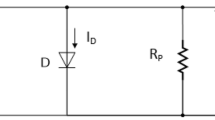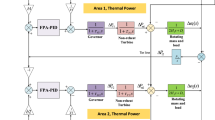Abstract
In recent era, the reduction of greenhouse gas emission and fuel consumption is accompanied by adopting photovoltaic (PV) and wind turbine-based hybrid renewable energy sources (HRES). In nature, an intermittent characteristic of the wind speed and solar irradiation makes these sources unpredictable, and hence, energy produced by wind and PV system generates uncertain conditions in operation of microgrid. In such cases, the security and reliability of microgrid are enhanced by integration of energy storage system (ESS). This work deals with an energy management in a hybrid system incorporating PV source and permanent magnet synchronous generator (PMSG)-based wind energy system. The PV output is enhanced with a help of switched trans-quasi-Z-source (TQZS) boost converter in which cuckoo search-assisted radial basis function neural network (RBFNN) approach is used as maximum power point tracking (MPPT) technique for tracking maximum photovoltaic power. The proposed approach results in high-power tracking efficiency with reduced power loss and settling time. A battery is incorporated to address an intermittent nature of RES. Artificial neural networks (ANN), which are capable of self-learning battery dynamics, keep track of the state-of-charge (SOC) of the battery. The system thus framed is implemented using MATLAB software, and promising results are generated in terms of power management with improved efficiency of 92%, gain ratio of 1:10 and total harmonic distortion (THD) value of 2.33%, respectively.




























Similar content being viewed by others
Data availability
Not applicable.
References
Babatunde OM, Munda JL, Hamam Y (2019) Selection of a hybrid renewable energy systems for a low-income household. Sustainability 11(16):4282
Kavin KS, Subha Karuvelam P (2021) PV-based grid interactive PMBLDC electric vehicle with high gain interleaved DC-DC SEPIC Converter. IETE J Res. https://doi.org/10.1080/03772063.2021.1958070
Mohamed MA, Eltamaly AM, Alolah AI, Hatata AY (2019) A novel framework-based cuckoo search algorithm for sizing and optimization of grid-independent hybrid renewable energy systems. Int J Green Energy 16(1):86–100
Rehman AU et al (2021) An optimal power usage scheduling in smart grid integrated with renewable energy sources for energy management. IEEE Access 9:84619–84638
Imran A et al (2020) Heuristic-based programable controller for efficient energy management under renewable energy sources and energy storage system in smart grid. IEEE Access 8:139587–139608
Pathak PK, Yadav AK, Padmanaban S, Kamwa I (2022) Fractional cascade LFC for distributed energy sources via advanced optimization technique under high renewable shares. In IEEE Access 10:92828–92842
Wu X, Tang Z, Stroe DI, Kerekes T (2022) Overview and comparative study of energy management strategies for residential PV systems with battery storage. Batteries 8(12):279
Kumar PS, Chandrasena RPS, Ramu V, Srinivas GN, Moses Babu KVS (2020) Energy management system for small scale hybrid wind solar battery based microgrid. IEEE Access 8:8336–8345
Benlahbib B, Bouarroudj N, Mekhilef S, Abdeldjalil D, Abdelkrim T (2020) Bouchafaa F (2020) Experimental investigation of power management and control of a PV/wind/fuel cell/battery hybrid energy system microgrid. Int J Hydrogen Energy 45(53):29110–29122
Eltamaly AM, Alotaibi MA, Alolah AI, Ahmed MA (2021) IoT-based hybrid renewable energy system for smart campus. Sustainability 13(15):8555
Shaw P (2019) Modelling and analysis of an analogue MPPT-based PV battery charging system utilising dc–dc boost converter. IET Renew Power Gener 13(11):1958–1967
Inomoto RS, Monteiro JRBdA, Filho AJS (2022) Boost converter control of PV system using sliding mode control with integrative Sliding surface. IEEE J of Emerg and Sel Topics in Power Electr 10(5):5522–5530
Abouchabana N, Haddadi M, Rabhi A, Grasso AD, Tina GM (2021) Power efficiency improvement of a boost converter using a coupled inductor with a fuzzy logic controller: application to a photovoltaic system. Appl Sci 11(3):980
Veerachary M, Khuntia MR (2022) Design and analysis of two-switch-based enhanced gain buck-boost converters. IEEE Trans Industr Electron 69(4):3577–3587
Rajavel A, Rathina Prabha N (2021) Fuzzy logic controller-based boost and buck-boost converter for maximum power point tracking in solar system. Trans Inst Meas Control 43(4):945–957
Liu K, Yang Z, Tang X, Cao W (2020) Automotive battery equalizers based on joint switched-capacitor and buck-boost converters. IEEE Trans Veh Technol 69(11):12716–12724
Pathak PK, Yadav AK, Padmanaban S, Alvi PA (2022) Design of robust multi-rating battery charger for charging station of electric vehicles via solar PV system. Electric Power Compon and Syst 50(14–15):751–761
Chandrasekar B, Nallaperumal C, Dash SS (2019) A nonisolated three-port DC–DC converter with continuous input and output currents based on Cuk topology for PV/fuel cell applications. Electronics 8(2):214
Al-Baidhani H, Kazimierczuk MK (2023) Simplified nonlinear current-mode control of DC-DC Cuk converter for low-cost industrial applications. Sensors 23(3):1462
Belkaid A, Colak I, Kayisli K, Bayindir R (2019) Design and implementation of a cuk converter controlled by a direct duty cycle INC-MPPT in PV battery system. Int J of Smart Grid-ijSmartGrid 3(1):19–25
Maroti PK, Esmaeili S, Iqbal A, Meraj M (2020) High step-up single switch quadratic modified SEPIC converter for DC microgrid applications. IET Power Electr 13(16):3717–3726
Nathan K, Ghosh S, Siwakoti Y, Long T (2019) A new DC–DC converter for photovoltaic systems: coupled-inductors combined Cuk-SEPIC converter. IEEE Trans on Energy Convers 34(1):191–201
Pathak PK, Yadav AK (2019) Design of battery charging circuit through intelligent MPPT using SPV system. Sol Energy 178:79–89
Aurairat A, Plangklang B (2022) An alternative perturbation and observation modifier maximum power point tracking of PV systems. Symmetry 14(1):44
Swaminathan N, Lakshminarasamma N, Cao Y (2021) A fixed zone perturb and observe MPPT technique for a standalone distributed PV system. IEEE J of Emerg and Selected Topics in Power Electr 10(1):361–374
Wijaya BH, Subroto RK, Lian KL, Hariyanto N (2020) A maximum power point tracking method based on a modified grasshopper algorithm combined with incremental conductance. Energies 13(17):4329
Hassan T-u, Abbassi R, Jerbi H, Mehmood K, Tahir MF, Cheema KM, Elavarasan RM, Ali F, Khan IA (2020) A novel algorithm for MPPT of an isolated PV system using push pull converter with fuzzy logic controller. Energies 13(15):4007
Owusu-Nyarko I, Elgenedy MA, Abdelsalam I, Ahmed KH (2021) Modified variable step-size incremental conductance MPPT technique for photovoltaic systems. Electronics 10(19):2331
Bakkar M, Aboelhassan A, Abdelgeliel M, Galea M (2021) PV systems control using fuzzy logic controller employing dynamic safety margin under normal and partial shading conditions. Energies 14(4):841
Subramanian V, Indragandhi V, Kuppusamy R, Teekaraman Y (2021) Modeling and analysis of PV system with fuzzy logic MPPT technique for a DC microgrid under variable atmospheric conditions. Electronics 10(20):2541
Ahmed S, Adil HMM, Ahmad I, Azeem MK, Huma ZE, Khan SA (2020) Supertwisting sliding mode algorithm based nonlinear MPPT control for a solar PV system with artificial neural networks based reference generation. Energies 13(14):3695
Tsai MF, Tseng CS, Hung KT, Lin SH (2021) A novel DSP-based MPPT control design for photovoltaic systems using neural network compensator. Energies 14(11):3260
Haseeb I, Armghan M, Khan W, Alenezi F, Alnaim N, Ali F, Muhammad AFR, Ullah N (2021) Solar power system assessments using ann and hybrid boost converter based MPPT algorithm. Appl Sci 11(23):11332
Jonnalagadda V, Sugavanam KR, Mohanasundaram K, Kuppuswamy CL, Bhukya R, Kadali KS (2021) Modified zeta converter based on ANFIS controller using MPPT PV system. In J of Phys: Conf Series 1916(1):012126
Benhalima S, Chandra A, Rezkallah M (2019) Real-time experimental implementation of an LMS-adaline-based ANFIS controller to drive PV interfacing power system. IET Renew Power Gener 13(7):1142–1152
Hui N, Luo Z, Feng Y, Han X (2020) A novel grid synchronization method based on hybrid filter under distorted voltage conditions. IEEE Access 8:65636–65648
Yousef AM, Abo-Elyousr FK, Elnozohy A, Mohamed M, Abdelwahab SAM (2020) Fractional order PI control in hybrid renewable power generation system to three phase grid connection. Int J Electr Eng and Inf 12(3):470–493
Rostami S, Abbasi V, Blaabjerg F (2019) Implementation of a common grounded Z-source DC–DC converter with improved operation factors. IET Power Electr 12(9):2245–2255
Aleem Z, Hanif M (2017) Operational analysis of improved Γ-Z-source inverter with clamping diode and its comparative evaluation. IEEE Trans Industr Electron 64(12):9191–9200
Takiguchi T, Koizumi H (2013) Quasi-Z-source dc-dc converter with voltage-lift technique. Proc. IECON, Vienna, Austria, pp 1191–1196
Senthilkumar S, Mohan V, Mangaiyarkarasi SP, Karthikeyan M (2022) Analysis of single-diode PV model and optimized MPPT model for different environmental conditions. International Transactions on Electrical Energy Systems.
Ali MN, Mahmoud K, Lehtonen M, Darwish MMF (2021) Promising MPPT methods combining metaheuristic, fuzzy-logic and ANN techniques for grid-connected photovoltaic. Sensors 21(4):1244
Oliver JS, David PW, Balachandran PK, Mihet-Popa L (2022) Analysis of grid-interactive PV-Fed BLDC pump using optimized MPPT in DC–DC converters. Sustainability 14(12):7205
Fapi CPN, Wira P, Kamta M, Badji A, Tchakounte H (2019) Real-time experimental assessment of Hill Climbing MPPT algorithm enhanced by estimating a duty cycle for PV system. International Journal of Renewable Energy Research.
Chalh A, Chaibi R, Hammoumi AE, Motahhir S, Ghzizal AE, Dhaifallah MI (2022) A novel MPPT design based on the seagull optimization algοrithm for phοtovοltaic systems operating under partial shading. Sci Rep 12(1):21804
Funding
The authors received no specific funding for this study.
Author information
Authors and Affiliations
Contributions
MS helped in conceptualization MS helped in data curation GGS and MS helped in methodology GGS worked in project administration GGS worked in supervision GGS helped in validation MS contributed to writing—original draft GGS and MS contributed to writing—review and editing.
Corresponding author
Ethics declarations
Conflict of interest
An authors have no conflicts of interest to declare that are relevant to the content of this article.
Ethical approval
Not applicable.
Additional information
Publisher's Note
Springer Nature remains neutral with regard to jurisdictional claims in published maps and institutional affiliations.
Rights and permissions
Springer Nature or its licensor (e.g. a society or other partner) holds exclusive rights to this article under a publishing agreement with the author(s) or other rightsholder(s); author self-archiving of the accepted manuscript version of this article is solely governed by the terms of such publishing agreement and applicable law.
About this article
Cite this article
Saranya, M., Samuel, G.G. Energy management in hybrid photovoltaic–wind system using optimized neural network. Electr Eng 106, 475–492 (2024). https://doi.org/10.1007/s00202-023-01991-4
Received:
Accepted:
Published:
Issue Date:
DOI: https://doi.org/10.1007/s00202-023-01991-4




